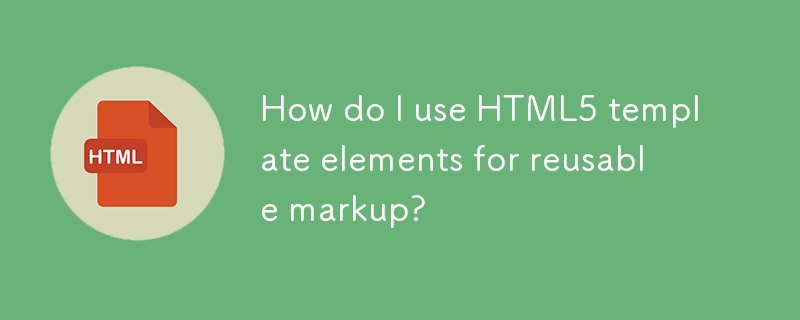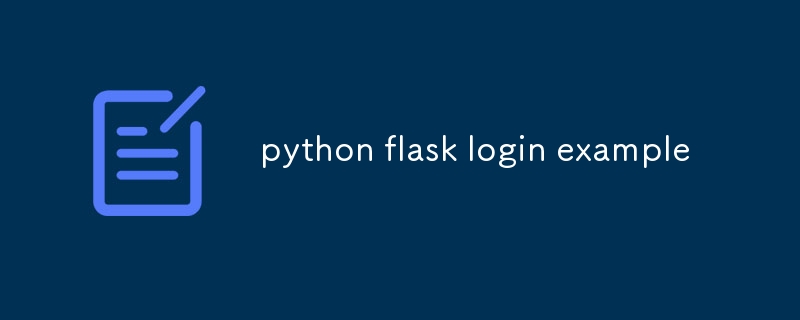Found a total of 10000 related content

HTML5 Template: A Base Starter HTML Boilerplate for Any Project
Article Introduction:Building your own HTML5 template: A concise guide
This article will guide you on how to create your own HTML5 template. We will step by step explaining the key elements of the HTML basic template, and finally providing a simple template that you can use and further build.
After reading this article, you will have your own HTML5 template. If you want to get the HTML template code now, read this article later, here is our final HTML5 template.
Key Points
HTML5 templates, as reusable templates, contain the necessary HTML elements, help avoid repeated code writing at the beginning of each project.
A basic HTML5 template should contain document type declarations, elements with language attributes, and passed characters
2025-02-08
comment 0
772

How do I use HTML5 template elements for reusable markup?
Article Introduction:The article discusses using HTML5 <template> elements for reusable markup, their benefits for code consistency, performance improvements, and integration with JavaScript for dynamic content.
2025-03-17
comment 0
381

Creating Reusable Content Structures with HTML5 Template Tag
Article Introduction:HTML5 tags are used to create reusable lazy content structures. The specific steps are: 1. Define the template; 2. Obtain and clone the template content through JavaScript; 3. Insert the clone content into the page. Its features include default invisible, support for any HTML, and require JS operations. It is suitable for scenarios such as component structure, dynamic loading, and preloading resources. The scripts and styles in the template need to be specially processed and cannot be nested in specific tags.
2025-07-06
comment 0
960

How to write a basic HTML5 page template?
Article Introduction:Declare the document as HTML5 to avoid the browser from entering weird mode; 2. Define the root element and specify the language to improve accessibility and SEO; 3. It includes ensuring correct character encoding, implementing responsive design, and setting page title; 4. Place all visible content, optionally add CSS, favicon and JavaScript links; this template is complete and compatible with modern browsers, and is suitable for any new HTML file.
2025-07-26
comment 0
1040

Using the HTML5 `` element for reusable content.
Article Introduction:Elements are native tools in HTML5 for storing unreleased HTML fragments, and can be efficiently reused after cloning through JavaScript. 1. Get template nodes; 2. Cloning content; 3. Filling data; 4. Inserting page. When using it, you need to pay attention to: the content and styles must be accessed through cloning, and must be defined separately and compatible with modern browsers. Suitable scenarios include dynamic lists, pop-up components, table rows and other duplicate structures.
2025-07-08
comment 0
508

Using the HTML5 `` and `` elements
Article Introduction:The sum elements in HTML5 can be developed componentically by defining HTML structures that are not rendered immediately and dynamic content placeholders. Used to create reusable DOM templates that are rendered only when inserted into the DOM by JavaScript; then serve as content insertion points, allowing custom content to be filled in different usage scenarios. The combination of the two can be used to build UI components with unified structure and dynamic expansion capabilities, such as modal boxes or tab pages. When using it, you should pay attention to: test the default content of the slot, avoid excessive nesting, keep the template simple, deal with script delayed execution issues, and pay attention to differences in slot behavior in ShadowDOM.
2025-07-13
comment 0
316



python flask login example
Article Introduction:This is a simple login example based on Flask-Login, including user login, session management, and login protection routing. 1. Install flask and flask-login dependencies; 2. Create app.py file and configure Flask-Login, simulate user data and login callbacks; 3. Implement login, logout and protected dashboard routing; 4. Use the template files login.html and dashboard.html for page rendering; 5. Log in with the user name admin and password password123 after running the application. The complete process covers flash messages, form processing and session retention, which is suitable for beginners to quickly master the Flask login mechanism. It is recommended to introduce the database in the future.
2025-08-01
comment 0
323

yii2 admin finished using
Article Introduction:Yii2 AdminLTE is a backend management system template based on the Yii2 framework and AdminLTE management template. It provides a wealth of controls and features that can help developers quickly build powerful backend management systems. Installation and use: Install through composer: composer requires kartik-v/yii2-adminlte to configure the AdminLTE module in config/web.php to run the migration command: yii migrate/up --migrationPath=@kartik-v/yii2-adminlte/migrations
2025-04-18
comment 0
476

Laravel user login function
Article Introduction:Laravel provides a comprehensive Auth framework for implementing user login functions, including: Defining user models (Eloquent model), creating login forms (Blade template engine), writing login controllers (inheriting Auth\LoginController), verifying login requests (Auth::attempt) Redirecting after login is successful (redirect) considering security factors: hash passwords, anti-CSRF protection, rate limiting and security headers. In addition, the Auth framework also provides functions such as resetting passwords, registering and verifying emails. For details, please refer to the Laravel documentation: https://laravel.com/doc
2025-04-18
comment 0
1193

How to handle user authentication in Laravel
Article Introduction:Laravel provides a simple and secure user authentication mechanism. It is recommended to use LaravelBreeze to quickly build basic authentication functions. 1. Install Breeze and run migration and front-end resource compilation to obtain login, registration, password reset and email verification functions; 2. Use auth middleware to protect routes, and the guest middleware to restrict unlogged users to access the login page; 3. Get the current user information through the Auth::user() or auth() helper function, and use @if(auth()->check()) in the Blade template to determine the login status; 4. You can manually call Auth::login() to achieve custom login logic, such as automatically login after social login.
2025-09-10
comment 0
460

How to use the HTML5 template tag
Article Introduction:TheHTML5tagstoresinert,reusableHTMLcontentthatcanbeclonedwithJavaScript;itremainsunrendereduntilprogrammaticallyinserted,makingitidealfordynamicallygeneratingelementslikeproductcardswithoutreloadingorhardcoding,anditsupportsadvancedfeatureslikedataat
2025-08-31
comment 0
923

What is the template element in HTML5?
Article Introduction:TheelementisuseSedostoreunrenderedhtmlcontenttentTentTtentTtTtTtTtTtentcanbeclonedandinsertdyNyLYLYVIAVIAVAScript; 1.contentinsideparsedbutnotrenderedoractive; 2.itupportslazyparsingandanconhanyvalidhtml; 3.itisaccantandesplonedandclonesDasedandanSedandan
2025-09-09
comment 0
521

How to build a simple login and registration form with Vue?
Article Introduction:This article provides a Vue-based front-end login registration form implementation solution, suitable for beginners. 1. Use Vue to manage the overall status and switch the login registration interface; 2. Create login and registration components that contain username and password input items and switch links respectively; 3. Handle login success and exit logic in the main instance; 4. The form implements data binding through v-model and performs basic verification; 5. It can expand the integrated backend request or enhance the front-end verification function.
2025-07-27
comment 0
388


10 JavaScript and jQuery Templates Engines
Article Introduction:Ten JavaScript and jQuery template engines worth learning
A template is a functional specification that generates output language strings (strings or AST forms) from a data packet using syntax similar to output results. Today, we have compiled ten JavaScript and jQuery template engines that you may be interested in.
Related readings:
10 jQuery layout tutorials
Sublime2 vs Notepad
10 random HTML5 network tools and resources
NANO – jQuery Template Engine
The simplest jQuery template engine, perfect for JSON parsing.
Source code and demo 2. "template" binding
2025-02-27
comment 0
472

How to work with the advanced project template in Yii
Article Introduction:To effectively use Yii2 advanced project templates, you must first install and initialize the environment through Composer, 1. Use composercreate-project to install the template, 2. Run phpinit to select the development environment, 3. Configure the database and perform phpyiimigrate application migration, 4. Point the web server to the frontend/web and backend/web directories, 5. Understand the division of labor between common, frontend, backend, console and environments directories, 6. Place a shared model in common/models and pass AccessCo in backend in backend
2025-08-22
comment 0
767

How to Fix Magento Login Issues with Cookies and Sessions
Article Introduction:This article is a collaborative effort with Ktree. Thank you to our partners who make SitePoint possible.
This article examines how Magento cookie misconfigurations can disrupt login functionality in both the storefront and admin backend, explains t
2025-02-09
comment 0
509

Building a PhoneGap App with a WordPress Backend
Article Introduction:This tutorial demonstrates using WordPress as a backend for a PhoneGap mobile application, focusing on creating REST APIs for seamless communication. We'll build a simple login and blog post display app. While PhoneGap itself is discontinued, the p
2025-02-18
comment 0
1082



















